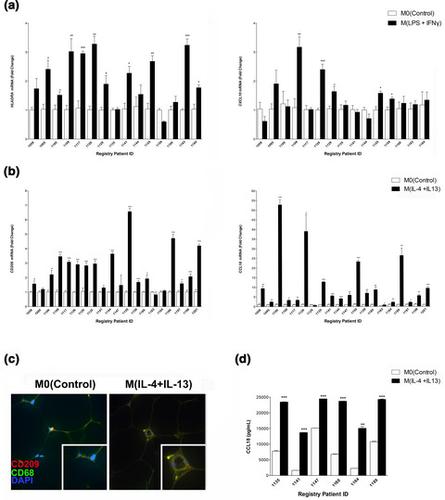当前位置:
X-MOL 学术
›
Immunol. Cell Biol.
›
论文详情
Our official English website, www.x-mol.net, welcomes your feedback! (Note: you will need to create a separate account there.)
The use of patient-derived breast tissue explants to study macrophage polarization and the effects of environmental chemical exposure.
Immunology and Cell Biology ( IF 4 ) Pub Date : 2020-07-26 , DOI: 10.1111/imcb.12381 Kelly J Gregory 1, 2 , Stephanie M Morin 2 , Alex Kubosiak 3 , Jennifer Ser-Dolansky 1 , Benjamin J Schalet 4 , D Joseph Jerry 1, 5 , Sallie S Schneider 1, 4, 5
Immunology and Cell Biology ( IF 4 ) Pub Date : 2020-07-26 , DOI: 10.1111/imcb.12381 Kelly J Gregory 1, 2 , Stephanie M Morin 2 , Alex Kubosiak 3 , Jennifer Ser-Dolansky 1 , Benjamin J Schalet 4 , D Joseph Jerry 1, 5 , Sallie S Schneider 1, 4, 5
Affiliation

|
Ex vivo mammary explant systems are an excellent model to study interactions between epithelium and stromal cell types because they contain physiologically relevant heterotypic interactions in the background of genetically diverse patients. The intact human mammary tissue, termed patient‐derived explant (PDE), can be used to investigate cellular responses to a wide variety of external stimuli in situ. For this study, we examined the impact of cytokines or environmental chemicals on macrophage phenotypes. We demonstrate that we can polarize macrophages within human breast tissue PDEs toward M1 or M2 through the addition of interferon‐γ (IFNγ) + lipopolysaccharide (LPS) or interleukin (IL)‐4 + IL‐13, respectively. Elevated expression levels of M(IFNγ + LPS) markers (HLADRA and CXCL10) or M(IL‐4 + IL‐13) markers (CD209 and CCL18) were observed in cytokine‐treated tissues. We also examined the impact of the endocrine‐disrupting chemical, benzophenone‐3, on PDEs and measured significant, yet varying effects on macrophage polarization. Furthermore, a subset of the PDEs respond to IL‐4 + IL‐13 through downregulation of E‐cadherin and upregulation of vimentin which is reminiscent of epithelial‐to‐mesenchymal transition (EMT) changes. Finally, we were able to show immortalized nonmalignant breast epithelial cells can exhibit EMT characteristics when exposed to growth factors secreted by M(IL‐4 + IL‐13) macrophages. Taken together, the PDE model system is an outstanding preclinical model to study early tissue‐resident immune responses and effects on epithelial and stromal responses to stimuli found both endogenously in the breast and exogenously as a result of exposures.
中文翻译:

使用源自患者的乳腺组织外植体研究巨噬细胞极化和环境化学暴露的影响。
离体乳腺外植体系统是研究上皮细胞和基质细胞类型之间相互作用的极好模型,因为它们在遗传多样性患者的背景下包含生理相关的异型相互作用。完整的人类乳腺组织,称为患者来源的外植体 (PDE),可用于原位研究细胞对各种外部刺激的反应。在这项研究中,我们检查了细胞因子或环境化学物质对巨噬细胞表型的影响。我们证明,通过分别添加干扰素-γ(IFNγ)+脂多糖(LPS)或白细胞介素(IL)-4+IL-13,我们可以将人乳腺组织PDE中的巨噬细胞极化为M1或M2。M(IFNγ + LPS) 标记物 ( HLADRA ) 的表达水平升高和CXCL10) 或 M(IL-4 + IL-13) 标志物(CD209 和 CCL18)在细胞因子处理的组织中观察到。我们还研究了干扰内分泌的化学物质二苯甲酮 3 对 PDE 的影响,并测量了对巨噬细胞极化的显着但不同的影响。此外,一部分 PDE 通过下调 E-钙粘蛋白和上调波形蛋白对 IL-4 + IL-13 做出反应,这让人联想到上皮间质转化 (EMT) 的变化。最后,我们能够证明永生化的非恶性乳腺上皮细胞在暴露于 M(IL-4 + IL-13) 巨噬细胞分泌的生长因子时可以表现出 EMT 特征。综合起来,
更新日期:2020-07-26
中文翻译:

使用源自患者的乳腺组织外植体研究巨噬细胞极化和环境化学暴露的影响。
离体乳腺外植体系统是研究上皮细胞和基质细胞类型之间相互作用的极好模型,因为它们在遗传多样性患者的背景下包含生理相关的异型相互作用。完整的人类乳腺组织,称为患者来源的外植体 (PDE),可用于原位研究细胞对各种外部刺激的反应。在这项研究中,我们检查了细胞因子或环境化学物质对巨噬细胞表型的影响。我们证明,通过分别添加干扰素-γ(IFNγ)+脂多糖(LPS)或白细胞介素(IL)-4+IL-13,我们可以将人乳腺组织PDE中的巨噬细胞极化为M1或M2。M(IFNγ + LPS) 标记物 ( HLADRA ) 的表达水平升高和CXCL10) 或 M(IL-4 + IL-13) 标志物(CD209 和 CCL18)在细胞因子处理的组织中观察到。我们还研究了干扰内分泌的化学物质二苯甲酮 3 对 PDE 的影响,并测量了对巨噬细胞极化的显着但不同的影响。此外,一部分 PDE 通过下调 E-钙粘蛋白和上调波形蛋白对 IL-4 + IL-13 做出反应,这让人联想到上皮间质转化 (EMT) 的变化。最后,我们能够证明永生化的非恶性乳腺上皮细胞在暴露于 M(IL-4 + IL-13) 巨噬细胞分泌的生长因子时可以表现出 EMT 特征。综合起来,



























 京公网安备 11010802027423号
京公网安备 11010802027423号